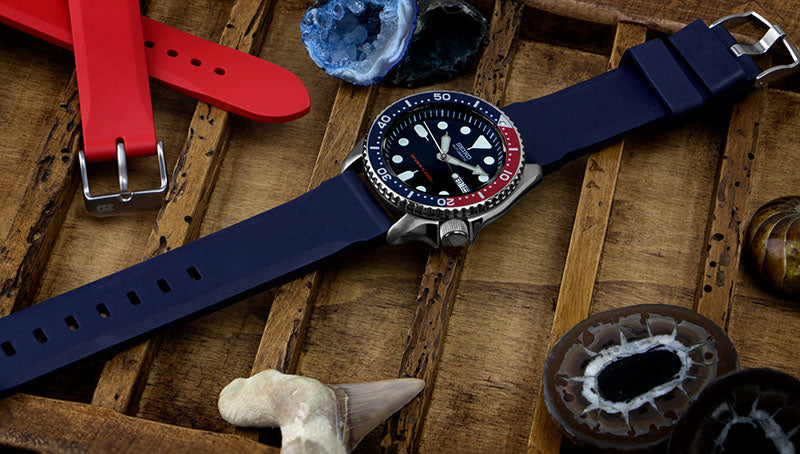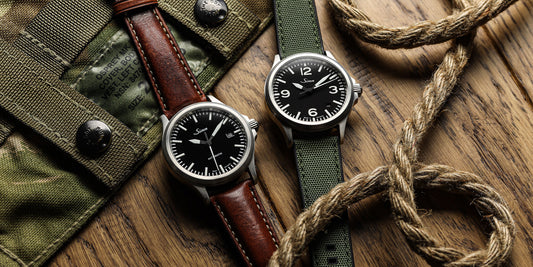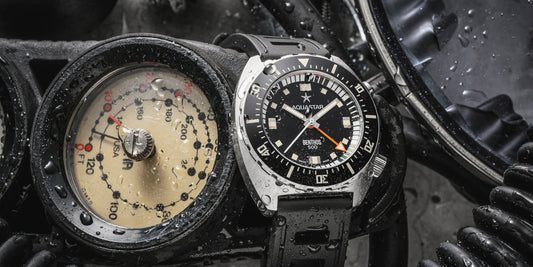The second part of our diving watches article, read our take on diving watches in military, commercial and leisure diving. From Omega Marine to Ressence...
Have you read Part 1 yet? Be sure to click here to catch up!
Over the following decades, a multitude of divers’ watches joined Rolex, Panerai, Omega, Breitling, Blancpain, ZRC and other pioneers. They were the remarkably accessible objects of desire, trusted tools and sought-after collectables for commercial, sports, military and ‘desk’ divers. You can view our own range of divers watches here, stylish and robust sports and diver's watches.
The reasons for people’s particular preferences, aside from hard to quantify, subjective preference and the general functional and associative reasons (see Coates for how product designers can achieve it) are diverse. For some, it might be the IWC Aquatimer’s innovative SafeDive System, the Oris ProDiver or DOXA’s SUB, which created ‘orange mania’ with its pioneering high-contrast orange face.
For others, it’s the adventuring spirit of the1947 Eterna KonTiki Diver used by Thor Heyerdahl that wins their heart. Then there are those for whom the 1967 LIP Nautic Ski (according to the company’s website, the first 200 m watch with an inner under-glass rotating bezel for safety) is the classic ‘diver’. By the way, surprise, surprise! The Nautic Ski was yet another watch associated with Jacques Cousteau.

Seiko’s Professional Diver 600
Let’s not forget Seiko’s ‘DOXA-esque’ orange and yellow-faced Monsters, or their earlier 20-patent Professional Diver 600, either. After the 1967 300M debacle (some of the watches reportedly burst under professional SAT diving conditions) the ‘600’ concluded nearly a decade’s development during which Seiko released no new divers’ watches. When it was eventually launched in 1967, the PD 600 was packed with innovations that subsequently shaped diving watch technology. It was also the watch that established Seiko’s place in the upper echelons of pro-quality dive watches.
There are so many others too, a veritable shoal of divers including, to mention a few, the Aquastar Deepstar, Stowa Seatime, Nivada Grenchen Depthomatic and Tornek-Rayville. And of course, schools of ‘divers’ from micro brands such as Korsbek, Kremke, Tigershark and Geckota…

Diving into the 1960s
An interesting view of the state of diving watches in the early 1960s comes from Urs Eschle, at the time, head of operations at Swiss manufacturer DOXA. In an interview for DOXA’s marketing, he says:
Back in the early Sixties, DOXA was one of the major Swiss Watch manufacturers with over 150 employees. When diving evolved from a being a military necessity and a profession to be a popular sport, and began to get popular among the masses, people who were fortunate enough to afford diving equipment relied on Rolex watches to use for diving. At those days, the term diver watch did not actually exist and a watch dedicated for diving or so-called "diver watch" did not exist either. DOXA was the first watch company to develop and offer a wristwatch primarily dedicated for sports diving purposes. The first ever sports diver watch was made by DOXA and introduced to public at the Basel show in 1966. It was also the first watch to be marketed as a piece of diving equipment from the CJS diver company and was also the first watch to be given the aqualung logo as a proof of reliability.
The growing interest in sport and exploration diving continued. Not least, with Jacques Cousteau’s continued high-profile activities. Cousteau bought the ocean into the homes of global audiences with films such as 1956’s award-winning Le Monde du silence (The Silent World), 1965’s Le Monde sans soleil (World Without Sun) and the long-running TV series, The Undersea World of Jacques Cousteau. The latter would dominate public awareness of the underwater realm for decades. And during this time, Cousteau and his ‘men fish’ would sport numerous Rolex, Omega, Blancpain, LIP, DOXA and other divers’ watches.
What happened to Hans and Lotte?
While considering film and TV diving pioneers, let’s not forget, as it’s so easy to do, Austrians Hans and Lotte Hass. In the 1950s, the couple engaged a generation of viewers with the hugely successful BBC series Diving to Adventure and the film Diving in the Red Sea. Gradually, however, the black and white charm of these productions started to look dated and the pair were eclipsed in the popular imagination by Cousteau’s full-colour adventures.
After leaving the limelight to focus on research in social sciences, Hass enjoyed a well-deserved resurgence of interest after Cousteau’s death. Note that the quiet Austrian’s work had begun in the 1940s. In fact, he’d already used an oxygen-based SCUBA set to film sea life and delight German-speaking cinema audiences before Jacques Cousteau perfected his Aqua-Lung in 1943. What’s more, Hass had written several best-selling books in German and English before Cousteau’s first book (The Silent World) was published. Since 2013, the year of Hass’s death, Blancpain has sponsored the annual ‘Hans Hass Fifty Fathom Award’ for achievement in diving, underwater photography and science.
Compared with the mass of available references to Cousteau’s watches, there’s a notable paucity of information about the Hass couple’s horological preferences. Dig a bit deeper, however, and there’s interesting information to be found concerning the Austrian’s development and promotional work on the 1955 ENICAR Sherpa 200 m underwater watch. In conjunction with Hans and Lotte, there are also references to ‘watches on white straps’ in online forum posts. Notably, however, still photography of the couple, and movie footage from the period, often shows watchless wrists!
Military divers’ watches after WW2
Of course, as we’ve already seen with Blancpain and ZRC, the post-WW2 years saw military importance of divers’ watches continue. First there was a massive requirement for disposal of wartime mines (including the concrete-encased German Katyminen that kept the Commando Hubert so busy around France’s coast) and other ordnance. Then, with the Cold War, Western divers had to address the challenge of a new generation of fiendishly ingenious, magnetically-activated Soviet-era mines. There were also various minor and not so-minor conflicts around the world, in places as different as Algeria, Vietnam and the Middle East…
Closer to WatchGecko’s Gloucestershire, UK home, with the discovery and subsequent boom of North Sea oil came unprecedented demand for commercial divers, many of whom were ex-navy. Additionally, there was the new terrorist threat against the strategically-important oil and gas production structures popping up between the UK and Norway.
As former SBS operative Don Camsell describes in his autobiographical memoir, Black Water, protection of these these assets gave new challenges to Britain’s British Special Boat Service (formed, as the Special Boat Service, in 1940). And to Norway’s combat swimmers (Marinjegerkommandoen) and clearance divers (Minedykkercommandoen (literally, ‘mine diving commandos’).
In a fascinating account of a practice assault on a North Sea oil rig, Camsell references, without specifically naming, his diver’s watch and compass board:
I slightly inflate my life jacket to gain some buoyancy and then swim towards the target. I press my face into the compass board to get some indication of the time we have been swimming. I estimate 22 minutes and decide to surface and see how near we are to the target…Towering above us, 250 metres dead ahead, is the black mass of an oil rig. Waves break against its gigantic steel legs. The equivalent of a 20-storey building looms out of the sea. Far above, lights glimmer through the spray.

In search of references to diving watches
Research for this article, in books such as the following, revealed that, while there are periodic references to divers’ watches and military swim boards, it’s unusual to find specific written reference to watch brands and models. Perhaps this isn’t surprising. Although we find the idea of a Submariner or Seamaster immensely exciting, when compared to the adventures of their pro-diver wearers, the watches details pale into insignificance. Here then are some of the best books that we discovered:
- The Loonliness of a Deep Sea Diver – David Harrison Beckett
- Black Water – Don Camsell
- First into Action – Duncan Falconer
- Target Tirpitz – Patrick Bishop
- Diver – Tony Groom
- Scuba Confidential – Simon Pridmore
- The Complete Diver: The History, Science and Practice of Scuba Diving – Alex Brylske PH. D.
- Frog Tales – Mark D Holroyd
- Divers: From Piper Alpha to the Gulf War – Jon May
- Labors in Liquid – Barry Gibbs
- Jacques Cousteau: The Sea King – Bradford Matsen
- Memories of a Commercial Diver – Neville Bransby
- The Real X-Men – Robert Lyman
- The Frogmen – Waldron & Gleeson
- Warriors from the Deep: The Extraordinary History of the Combat Swimmers – Erich Micheletti
- Maritime Spezialeinheiten – Michael G Welham
- Clearance Diver – Tony Ey
- Neutral Bouyancy – Tim Ecott
All the above are well-written and great reads. Referenced singly, or together, they give excellent context for the military and civilian use of divers’ watches in the UK and worldwide since the 1930s. For visual watch references, the pictures in Harrison Beckett’s book should particularly delight fans of 1970–80s Rolexes. Equally, the images in Micheletti should keep ‘Paneristi’ and other ‘watch spotters’ entertained for hours.
Since WW2, military special forces around the world have used various standard and special ‘military issue’ divers’ watches. These have been supplied by manufacturers such as Blancpain, Rolex (Submariner and Military Submariner – the MilSub), Omega (Seamaster, including France and the UK), ZRC and others. Not surprisingly, the watchmakers have been quick to capitalise on their military experience. An excellent recent example is Jaeger LeCoutre’s Master Compressor Diving Automatic Navy Seals Caliber 899, which was developed in close collaboration with US special forces.
In his very readable article, The Military Diver’s Watch – A Revisionist View (www.timezone.com), James Dowling gives fascinating insight into post-WW2 evolution of British military diver’s watches, initially in conjunction with Rolex. Of particular note is how development of various Submariner references during the 1950s consistently outpaced the British Ministry of Defence’s ability to test and evaluate the evolutions of the watch. Eventually, according to Dowling, Rolex ‘Subs’ were issued to the Royal Marines’ Special Boat Service, the SBS. They quickly identified the need for a special version (with easier-to-operate bezel and solid strap bars) – the reference 6540. Later still, the SBS, along with other nations’ military divers, also used the Omega Seamaster.

The diver’s watch in popular culture
If you’re expecting an exhaustive review of divers’ watches in popular culture, you’ll be disappointed again. Once more, it’s done in much more detail elsewhere. However, what we are going to do is reference a few famous examples from cinema and fiction, that interest us – and you too, we hope.
In an earlier WatchGecko article, we looked at the much-discussed appearance of a supposed ‘Military Nylon’ strap on Sean Connery’s Rolex Submariner in the James Bond movie Goldfinger. Rather than revisit the subject here, you can read the article elsewhere on the WatchGecko website.
Fleming, Cousteau and Bond
What is worth noting again is the strong affinity that James Bond creator, Ian Fleming, had for his Rolex. But it wasn’t a Rolex Submariner, despite the period when Fleming wrote the books, starting with Casino Royale (1953), corresponding with the rise in popularity of this watch.
So what did he wear? An online search, or careful examination of images in Andrew Lycett’s highly readable Ian Fleming, reveals that Bond’s creator sported a stainless-steel Rolex Explorer. Apparently, it was a reference 1016, with screw-down crown and 100 m water resistance. We understand that it was the only Rolex that Fleming ever owned or wore until his death in 1964.
But we digress. We’re talking divers’ watches, so what better than to harness the power of Kindle, search through the Fleming catalogue for ‘Rolex’ and see what we find. Given Fleming’s predilection for detail, you might expect to find very specific references to different watches – including the Submariner. And, because of diving-related storylines, you’d expect to find such references in several books. But you don’t, which is doubly surprising given Fleming’s admiration for Jacques Cousteau. And his friendship with the sometime-Rolex-Sub-wearing Frenchman (they dived together), which undoubtedly left what the author Tim Ecott describes as ‘a legacy of diving images in his novels’.

How many Rolex references?
Remarkably, our search revealed just 10 Rolex references. In only one (On Her Majesty’s Secret Service) does Fleming specifically name Bond’s watch (a Rolex Oyster Perpetual). In Thunderball, with its dive-centric plot, Fleming describes a ‘solid gold Rolex Oyster Perpetual Chronometer’. However, it isn’t worn by Bond, but by the villain Petachi who hijacks a ‘Vindicator’ V-Bomber, then ditches the aircraft so its weapons can be stolen. In the Thunderball film (for many years the most successful Bond movie), Sean Connery again wears a Submariner – as well as a Breitling Top Timer chronometer equipped with a Geiger counter. Interestingly, watch enthusiasts’ discussion about divers’ (or any) watches in 1983’s non-EON ‘Thunderball remake’, Never Say Never Again’ (Rolex? Oris? Seiko?) appears much less than for other Bond movies. As far as I can establish, the identity of this watch is one of the few Bond watch mysteries – with the potential for a story not unlike the Jaws ‘Hooper watch’ mentioned elsewhere…
And that’s it for Fleming’s writing – no reference to an Explorer, let alone a Submariner, a ‘diver’s watch’, a ‘rotating bezel’ or anything similar in all his output. Later, as we know, Bond switched allegiance to Omega on the big-screen. But that’s another story…

Dirk Pitt and the DOXA SUB
Staying with printed novels (or, as is often the case now, digital fiction on an e-reader), we’d be remiss not to mention another fictional adventure hero. Just like James Bond, this one (and his creator) has played a part in the popularity of divers’ watches in popular culture – and real-life watch sales!
Clive Cussler’s Dirk Pitt and his orange-faced DOXA watch first appears in Pacific Vortex (in practice, the sixth Dirk Pitt novel to be published). As far as we can ascertain, the exact model is never stated in the books. But it’s likely to be an original SUB 300T, like the one Cussler himself wore from the late 1960s. The distinctive watch ultimately featured in many of the Dirk Pitt series, including Iceberg, which gives us the following, among several references:
As he sank deeper and deeper, the light diminished and the visibility shortened. He checked his two vital references. The depth gauge read ninety feet and the orange dial on the DOXA diving watch notified him that he had been down two minutes.
Over the years, Clive Cussler (later, Dr. Clive Cussler) and his fictional hero have been outstanding ambassadors for the orange-faced vintage divers’ watch. So much so that in 2003, the author was given DOXA SUB 600T Professional with serial number 001/3000. This followed the previous year’s presentation of serial numbers 001/1000 of the reissued SUB 300T Seahunter and SUB 300T Professional. That seems like fair recognition, given the publicity that Dirk Pitt has given to the Biel, Switzerland watchmaker over the years!

Sly’s Panerai
With Panerai holding such a prominent place in the story of divers’ watches, it’ll be no surprise that the Italo-Swiss brand’s distinctive timepieces have often appeared in popular culture.
Jason Statham’s PAM204 in The Mechanic, Hugh Grant’s Panerai Luminor Marina in Bridget Jones’s Diary and Dwayne ‘The Rock’ Johnson’s Panerai Submersible Amagnetic in San Andreas are just three examples. Most famous, however, is probably the association between Sylvestor ‘Sly’ Stallone and Panerai. It began with the actor’s spur-of-the-moment purchase of a Panerai when filming scenes for 1996‘s Daylight in Rome. Subsequently, as an A-list ‘Paneristi’ Stallone regularly wore Panerai (apparently, always on his right wrist) and built a strong relationship with the company. This was formally recognised when the watchmaker created a dedicated Panerai ‘Slytech’. For trivia fans, It’s worth noting that after the Rome trip Stallone gave a Panerai Luminor Marina to his friend Arnold Schwarzenegger. When Arnie wore the watch in Eraser (released six months before Daylight), the Austrian-American actually showcased the brand before Stallone!
The mystery of the ‘Jaws watch’
And to complete a trio of interesting big-screen appearances by divers’ watches? How about the watch worn by oceanographer Matt Hooper (Richard Dreyfuss) in Jaws? For decades, the identity of the watch remained a mystery to enthusiasts. Then, in 2010, and to much excitement, it was rumoured, and then announced, that the ‘Hooper watch’ had been identified. Even more exciting, the make and model of the mystery ‘diver’ would be announced. And it was, in a fascinating 2010 WatchTime article by Gary and Christian Stock that documented several years’ research into the ‘best-known unknown timepiece in history’. As promised, the article identified the watch as an Alsta Nautoscaph – with a neat plot development that wouldn’t be out of place in a Hollywood blockbuster …

Continuing fascination with ‘divers’
Decades of Jacques Cousteau’s underwater documentaries, Bond movies, Stallone Panerais and the ‘Hooper watch’ demonstrate that watch enthusiasts’ fascination for ‘divers’ continues unabated. It’s just another aspect of the appeal for many owners, wearers and collectors. Anyone, in fact, who enjoys rare and commonplace, pricey or ‘very reasonably priced’ examples of these versatile, rugged and extremely practical timepieces.
In Neutral Bouyancy by Tim Ecott, the author comments, somewhat revealingly, on how ‘the anthropology of a diving group always fascinates me.’ Ecott continues as follows:
Male divers, like male car drivers, are often preoccupied with the brand of diving equipment they possess, and compare buoyancy jackets and regulators [and watches?] just as they might discuss engine size and torque in a sports car. Ego and the relative size of a diver’s disposable income are part of the equation for many men, as with all gadget-based pastimes. Femaie divers are often (like women drivers) less interested in the technical specifications of their equipment, just as long as it does the job for which it was designed.’
Sounds familiar?
Often, and the present writer puts his hands up and confesses to this too, the fascination isn’t borne of a direct professional or recreational involvement in diving either. I’ll be the first to make this confession about my ‘cushion case’ Geckota K3 (paid for by me, not a ‘freebie’ from WatchGecko, before you ask). It’s unlikely to go beyond the deep-end of a swimming pool or a swim in the blue waters of Shetland or Sweden’s west coast – despite its 200-metre rating. Yes, this article is being written by an unashamed ‘desk-diver’. And that means, if we’re honest with each other, that I’m probably just like many of you who are reading this.

Experiencing the magic of a ‘diver’
So what’s the appeal of a ‘diver’ that’ll probably only get a soaking if I forget to remove it and its orange rubber ZULUDIVER strap before washing up or showering?
Whether it’s the K3, the classic Seamaster I’m considering, or the Stowa Seatime, Laco Tundra, Sinn U2, Certina DS and Submariner-inspired Steinhart Ocean that are ‘in the frame’, there’s a thrill in owning and wearing a ‘diver’. And something about buying into the tradition of exploration, history and evolving watch technology that comes with quality diving watches. I think it’s about the association with an exotic world and using a ‘professional-quality’ tool well within its capabilities – while knowing what it could do if it had to. And, of course, alongside high legibility and the security of excellent water resistance, ‘divers’ wear well in a wide range of business, social and sports environments. They also look cool!

Forget knock-offs or cheap copies
Even if your budget doesn’t run to thousands, or tens of thousands, there’s pleasure in even a humble-but-beautifully-executed entry-level homage watch inspired by the classics, the way the K3 is. Forget knock-offs or cheap copies like the ‘€70 Omega Seamaster Planet Ocean’ you were offered on holiday in Turkey. Instead, think of timepieces inspired, designed and manufactured with integrity and respect for the classics – to deliver a decent everyday watch at a sensible price.
Okay, so the K3’s movement is the Ford Mondeo of automatics, Miyota’s proven 8215. But for the money (read Watchuseek’s reviews if you don’t believe me), it’s amazing. While writing this article, I got independent proof of this when asked about the K3 by a watch enthusiast. Though well acquainted with Longines, Seiko ‘divers’ and Omega Seamasters, he hadn’t discovered Geckota. Even I was amazed when, after handling the watch, and with no more information than that it was Miyota-powered, he positioned the K3 and strap as a £400 watch!
As if that wasn’t interesting enough, the same person told me about a friend, a former commercial diver, who had owned and used dive watches across the complete price spectrum. This former diver maintained that, in his experience, one of the best performing divers’ watches was actually one of the cheaper, less well known, makes. Interesting indeed, and a story to sit alongside the oft-told tale of a $15 Casio that emerged from a deep-sea immersion trial in better condition than watches costing hundreds of times as much.

I’d better buy into the ‘diver’ experience
I came to wear the K3 on impulse. I’d been wearing one of WatchGecko’s K-01s for months and loved its understated Germanic style. Then, at 06:14 one morning, knowing I was due to write about divers’ watches, and having never owned one, I thought I’d better buy into the ‘diver’ experience. Minutes later the deed was done. And just over 24 hours later, the K3 arrived.
I had just, in my small way, bought into the tradition of diver’s watches. As we’ve seen, it’s a rich tradition, begun by Omega and Panerai and continued through WW2. And then, after the war, the movement gained further impetus from the likes of Cousteau, Maloubier, lifetime Rolex-wearer Lloyd Bridges and the glamorous Zale Parry in Sea Hunt, and others.
Nowadays, serious divers generally use sophisticated wrist-mounted dive computers (probably backed up by a super-accurate quartz diver). Regardless of this, the idea of a traditional divers’ watch – stylish, durable, functional and redolent of everything to do with the exotic world of underwater warfare, exploration and leisure – remains. And another generation of watch lovers is hooked.

I just ‘got’ the magic of a ‘diver’
It’s an exciting feeling. Buying my micro-brand diver’s watch was essential. It helped me understand first-hand how the characteristics of these watches, evolved through trial and test over the best part of a century, give meaning to even my entry-level watch. I fastened the bright orange ZuluDiver and felt the weight of the K3. Then I just ‘got’ what the precision unidirectional bezel and chunky 1950s-style cushion case represented (I later read a Watchuseek reviewer likening the K3 to 1940s California dial Rolex bubblebacks and Viceroys). Similarly, the brightly-lumed hands (SuperLuminova like many a super-luxury watch!) and beautifully precise screw-down crown. It all adds up to an easy-to-read, water- and dust-resistant mini-masterpiece with a reliable movement at its heart.
Though it only cost £99 (plus the strap), it’s a lovely thing to own, use and look at. It’s as if I carry a little of the spirit, the DNA, of Beebe, Alexandria, Cousteau and Annecy’s pro-plongeurs with me on my wrist. And all for a fraction of a Seamaster’s ticket price…I still fancy the SM, but it gets you thinking…

It’s time to take the plunge
Hopefully, I’ve got you thinking too. If you’ve a ‘diver’ in your collection, kick back and take a minute to think back over its illustrious lineage, evolution and influences.
And if you haven’t? Surely it’s time to follow in the bubble-stream of Cousteau, Maloubier and those SBS operatives, and take the plunge. If your experience is like mine, you’ll love what a ‘diver’ does for you and your image. And if you’re like me, you’ll adore the experience – even if the wettest it gets is in the shower before you head to your office and join the rest of us ‘desk divers’!





